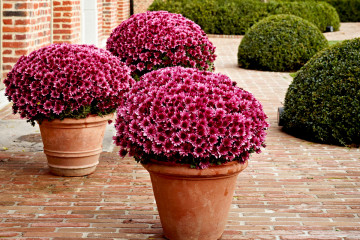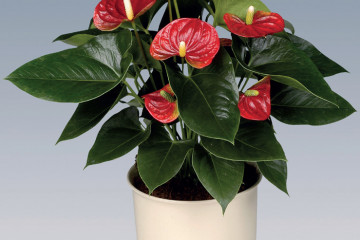Chrysanthemum chamomile - what is this flower
Content:
Chrysanthemum chamomile is a worthy decoration of the garden, but it can also create coziness in the room. It looks like a chamomile in its appearance, but the difference lies in the larger size and different color options for colors.
Chrysanthemum chamomile - what is this shrub plant
Chrysanthemum "chamomile" refers to perennial shrubs that have umbrella-shaped inflorescences. The flower belongs to the Astrov family.
The first mentions of a flower date back to the 5th-6th centuries. BC. Initially, they were grown only indoors in China and other Asian countries, but over time, breeders managed to breed a bush plant. The second homeland of these flowers is rightfully called Japan. Since the end of the 18th century, it was brought to the territory of Europe.
All small chrysanthemums, like chamomile, have simple, semi-double inflorescences. The core of such a flower includes short tubular petals, colored yellow.
The foliage on the plant is large, green or dark green in color. Each sheet has serrated edges. The stem of the plant is quite sturdy and thick.
The use of chamomile chrysanthemums in landscape design and in bouquets
Tall varieties of chamomile multi-colored chrysanthemums are most often used to decorate the central part of flower beds, and undersized bushes look beautiful along paths and borders. Flowers grow well next to coleus, marigolds, conifers.
Florists collect various bouquets and compositions from small chrysanthemum flowers. In addition, they are used to make head wreaths, boutonnieres, etc. The foliage of the plant can be decorated with a special sheen, which gives the overall appearance of the bouquet a zest.

Florists, when decorating bouquets of chamomile chrysanthemums, can decorate them with decorative elements
Varieties of indoor plants
Breeders have done a great job on a variety of varieties - chrysanthemum or chrysanthemum-chamomile inflorescences differ depending on the variety. Below are the names of the most popular varieties.
Chrysanthemum Inga (Inga Chrysanthemum)
It is an artisanal plant with anemic inflorescences. The middle of not fully opened inflorescences is green; as it unfolds, it becomes yellow. The marginal petals are white or beige.
On erect stems, green leaves, feathery along the edges, grow. The height of the bush reaches 70 cm.
Chrysanthemum Camille (Camille Chrysanthemum)
This variety is the closest in appearance to chamomile. Small flowers reach up to 4 cm in diameter. The middle is yellow and the petals are white.
Chrysanthemum Lacemaker (Chrysanthemum Crugevnica)
This variety belongs to the autumn. The middle of the flower is yellow.
Chrysanthemum bushes grow up to 55-77 cm high.The corolla size reaches up to 8 cm.
Chrysanthemum Prosseco
The bush has many small flowers. In the center is a core of small tubular green petals. The diameter of the inflorescences does not exceed 6 cm. Proseco is valued for its large number of flowers and a long freshness after cutting.
In addition to the varieties considered, there are others. For example, chrysanthemum Red Chamomile, Malchish-Kibalchish, Yellow Ring, Santini Tedcha, Arlina, Lisboa, Monagua, etc. The color of the petals of chamomile chrysanthemums can be varied - white, yellow, blue, purple, lilac-pink, etc.
Growing chamomile chrysanthemums outdoors and at home
Growing a flower in the house and outdoors have similar rules. Growing a beautiful, flowering bush on a window is possible only with good light. At the same time, the bush will need sufficient lighting on the street.
How to care for a flower at home
To grow a flower at home, you need to know some rules of care. No special procedures are required, but there are a few nuances.
- Illumination and temperature conditions
The flower is very light-requiring, even diffused light is not suitable for full growth. In indoor conditions, the east or south side will suit him.
In greenhouse conditions, the ideal temperature for chrysanthemums is 13-18 ° C. When temperatures rise above 19 ° C, the flowering period ends. The maximum temperature is 25 ° C - already at this stage, the leaves may turn yellow from excessive heat.
- Watering rules and humidity
Chrysanthemum chamomile, both white and other colors, loves moist soil, but within normal limits. Watering should be done after half of the soil in the pot has time to dry.
- Top dressing and soil quality
For planting or transplanting plants, use a universal soil. To achieve a looser structure, vermiculite and sand are added to it. Feeding the plants begins in spring and ends in autumn.
After each feeding, at least 1-2 weeks should pass. It is possible to fertilize the soil in which the plant is located with complex mineral compositions.
- Flower container size
You need to carefully choose a pot for a plant. The capacity for chamomile chrysanthemum should not be much larger than the size of its root system.
- Pruning and replanting
After the end of flowering, the chrysanthemum is pruned every autumn. All stems are cut, leaving only hemp 5 cm high. Leaves are removed completely.
It is necessary to replant young bushes annually for 5 years. Adult bushes are trans-shipped after 2-3 years.
Planting and caring for a plant when grown outdoors
On the street, chamomile chrysanthemum is planted in May or early September until the onset of frost.
Care consists in timely watering, removing wilted flowers. If in winter frosts reach -30 ° C, the bushes should be covered with mulch or spruce branches.
For the rest, the rules of agricultural technology do not differ.
Features of flowering plants
With proper care and the beginning of a reduction in daylight hours, the flower begins to expel the buds. With sufficient light, the plant will be covered with many flowers.
The flowering period lasts about 10 weeks, this period depends on the variety. After the end of flowering, a dormant period begins until the onset of spring.
Flowers can be in the form of baskets or have more complex terry inflorescences - it all depends on the specific variety. The diameter of the flower also depends on the variety and ranges from 3-8 cm.
Flower propagation methods, when it is better to do it
When growing a chamomile chrysanthemum, you need to know how to reproduce a flower. There are two ways to get new plants.
- Seed propagation
Seeds are sown in the ground at the end of February or the first days of March. After 2 weeks, the first shoots will appear. After the appearance of 3 leaves, the sprouts can be dived.
When the soil temperature becomes more than 12 ° C, seedlings can be planted in a permanent place.
- Propagation by cuttings
Cuttings are taken from the tops of the shoots, you can cut them off at any time from spring to autumn. You can root cuttings in water or soil.
Propagation by cuttings allows you to preserve all the characteristics of the selected variety.
Growing problems, diseases and pests
Like other flowers, chamomile chrysanthemum can be sore. Most often, she suffers from fungal diseases.
And the most common pests are:
- aphid;
- mite;
- thrips.
How to deal with them
To get rid of a flower from a disease, drugs such as "Topaz", "Fundazol" are used. A weakened bush can be treated with Zircon.
If pests have been noticed on the plant, spraying with Fitoverm should be carried out 3 times every 5 days. "Aktar" will help to fight root pests.
Chrysanthemums similar to daisies will not leave anyone indifferent. Knowing the basic rules of care, even novice gardeners will be able to grow a beautiful and attractive flower without any difficulties.




















